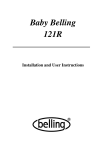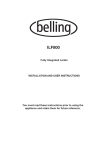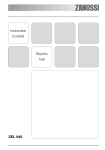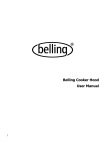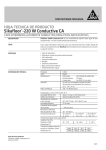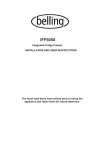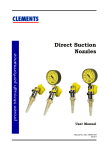Download Belling Baby 321R
Transcript
Baby Belling 321R Installation and User Instructions Installing Your Cooker Your Belling Cooker Even if you have used an electric cooker before, it is important that you read these instructions thoroughly before starting to cook, paying particular attention to the installation and safety instructions. Getting help If you have any problems with installing, operating, or cooking with your Belling Cooker, please check through these instructions thoroughly to make sure that you have not missed anything. If you still need help, then please contact: Belling Customer Care Centre Stoney Lane Prescot Merseyside L35 2XW Tel 0844 815 3746 If your query relates to cooking then please write to the Senior Home Economist at the same address. Details of how to contact a Belling Approved Service Agent, should your cooker ever require maintenance, can be found in the ‘Care of your cooker’ section of this book. Please quote the cooker model and serial number with all enquiries, this can be found on the voltage label which is located on the outer back panel. WARNING! For your own safety, make sure that these instructions on installation, use and maintenance are followed. We advise you to keep these instructions in a safe place for future reference. if you sell or transfer ownership of this product, please pass on these instructions to the new owner. This appliance is not intended for use by persons (including children) with reduced physical, sensory or mental capabilities, or lack of experience and knowledge, unless they have been given supervision or instruction concerning use of the appliance by a person responsible for their safety. Unpacking After unpacking your cooker, make sure that you remove all the packing from the oven and grill compartment, and the packing from under the hob on radiant ring models, and any stickers from the oven door and the hob. Examine your cooker for any damage. If there is any damage to your cooker or anything is missing, please contact your supplier for advice. Locating the cooker Your cooker must stand on a flat surface, or be fitted to the special Belling stand, so that when it is in position the hob is level. Make sure that the cooker is stable and cannot be rocked. If it is used between units, allow 10mm (3/8”) clearance on each side. It must not be situated with either side closer than 150mm (6”) to a wall or cupboard that is higher than the hob. Do not remove the cooker feet. Any overhanging surface or cooker hood should be at least 450mm (18”) above the cooker hob. We do not recommend positioning the cooker below wall cupboards, as the heat and steam from the cooker may cause damage to the cupboards and its contents. Make sure that the walls near the cooker are resistant to heat, steam, and condensation. 2 Installing Your Cooker Connecting the cooker For your own safety, we recommend that your cooker is installed by competent electrician. The installation must comply with current I.E.E. Wiring regulations Warning: This appliance must be earthed The cooker must be connected to the correct electrical supply as stated on the voltage label, through a suitable cooker control unit incorporating a double pole switch having a contact separation of a least 3mm in all poles. It must not be connected to a 13amp plug. We recommend you use 2.5mm² twin and earth cable to connect the cooker to the mains supply The cable should be connected to the mains terminal block as follows; Connect the Green & yellow lead to the terminal marked Connect the Brown lead to the terminal marked Connect the Blue wire to the terminal marked “L” “N” Ensure that the cable is clamped using the clamp provided. Allow sufficient cable length for the cooker to be pulled out for cleaning, but do not let it hang closer than 50mm (2”) to the floor.The cable can be looped if necessary, but make sure that it is not kinked or trapped when the cooker is in position. 3 For Your Own Safety When used properly your Baby Belling Cooker is completely safe, but as with any electrical appliance there are some precautions you must take in its use. Never ... • allow anyone except an authorised Belling Service Agent to service or repair your cooker. • remove any part of the cooker other than those intended in normal use, or attempt to modify the cooker in any way. • use the cooker for commercial catering. It is designed for domestic use and for cooking food only. • allow young children to operate or play with the cooker. • use a chip pan or deep fat fryer more than 1/3 full of oil, or use a lid while frying, and do not leave a fryer unattended while cooking. • operate the grill with the oven door closed. This may cause overheating of the cooker. • line the shelf, floor, or sides of the oven, or the radiant ring hob spillage tray with aluminium foil as overheating and damage may result. • place anything which might catch fire, such as towels or tea towels, on the hob or elements, even when the cooker is not in use. • use an asbestos mat, trivet or rack of any kind under pans on the hob. • store anything which might catch fire in the oven. • take care when touching any part of the cooker which may be hot. Use oven gloves when removing or replacing food or dishes. • stand back when opening the oven door to allow any build-up of heat or steam to disperse. • keep the oven door closed when not in use to prevent accidents, but remember that the oven door must be kept open when grilling to prevent overheating. • make sure that the roof, floor, and shelf are fitted correctly before using the oven or grill. keep your cooker clean, as a build-up of grease or fat from cooking may be a fire hazard. Always . . . • • switch off at the mains supply before cleaning your cooker. • supervise children and pets, particularly when grilling, as exposed parts of the grill may become hot. use suitable pans for the hob, and make sure that they are stable. • Before Cooking • keep handles away from the edge of the hob and any heat. For added safety you should consider using a suitable hob guard. • make sure that all the controls are switched off when you finish cooking. • remember that your cooker may stay hot for a time even after you have finished cooking. Before you cook for the first time , we recommend that you switch on each element in turn to burn off any odours remaining from manufacture. Simply operate each hob element and the grill on maximum for a few minutes, and the oven for about 30 minutes. 4 Controls Left hand boiling ring Grill switch Oven thermostat Right hand boiling ring Power on Power ON neon Oven ON neon This lights up to show that the cooker is switched on at the mains, even if it is not being used. Oven + selector 0 This is the ‘off ’ position. When this is selected, only the hotplates can be used. 0 – 245 This is the oven temperature range. During use the appliance becomes hot. Care should be taken to avoid touching heating elements inside the oven. Using the oven Never operate the oven without the grill/oven roof and the oven floor in position. Make sure that the oven shelves are pushed fully in to the oven before closing the oven door, and close the door gently. In some conditions steaming around the oven door may occur. This is perfectly normal and does not indicate any fault with the oven door or seal. Do not place heavy loads on the oven door when it is open. Oven control The control is graduated with the main cooking temperatures indicated. Remember that you may select any position between those indicated if you so wish. Turn the switch until the desired temperature is set. The neon indicator will stay alight until the desired temperature is reached, (approximately 20 minutes depending on the selected temperature), when it will go out. The neon indicator will then continue to go on and off as the thermostat maintains the oven temperature automatically. 5 Controls Grill This is the grill position. This position can only be set by rotating the knob in a clockwise direction. Using the grill We recommend that the grill is preheated for at least five minutes before placing the food under the grill. After sealing the surface of the food reduce the heat as required. Remember to keep the oven door open when grilling or preheating. The grill/oven roof should be removed regularly for cleaning, but must always be replaced before the grill or oven is used. A dirty grill roof can cause the grill to smoke when it is used. When grilling, the oven door must be fully open to prevent overheating. NOTE: The grill output can not be regulated. Therefore food requiring less intense heat should be located on a lower shelf position. The selector switch will not rotate past the Grill position; therefore it can only be switched off by rotating anti clockwise Using the hob Oven/grill pan and grid The hotplate controls can be operated by turning them in either direction to the desired setting ‘0’ for off, between 1 and 3 for low simmering, and between 4 and 6 for fast simmering and boiling. We recommend that pans are brought to the boil on setting 6 (maximum) and then the heat reduced as necessary. To obtain the best results, always use the wire grid when grilling. This will ensure that foods do not cook in their own fats and will prevent any distortion of the grill pan. It can be used either way up to position the food nearer to or further away from the grill element. The grill pan is usually used in the middle position in the oven for grilling. To avoid burning or excessive smoking and spitting, make sure that the food is not too close to the grill element. Always use an oven glove when replacing the grill pan. Oven shelf The three runner positions and shelf give a variety of cooking positions in the oven. The shelf is cranked, and can be used either way up to give intermediate heights. Do not place food or empty dishes on the floor of the oven during cooking. The shelf simply slides in and out. Be careful, when pulling the shelf out with food on it that you do not pull it out to far. Oven pans When cooking food which might boil over, place the dish on a tray or larger dish on the shelf to catch spillage. Do not line any part of the oven, including the floor, with aluminium foil as this can cause damage. You can, of course, use foil to cover foods during cooking 6 Care of your cooker In the interests of both safety and hygiene your Belling Cooker needs to be kept clean. A build-up of grease or fat from cooking could cause a fire hazard. WARNING! For your own safety, always switch off your cooker at the mains supply before cleaning. Never use excessive amounts of water to clean your cooker, and remember that your cooker is heavy - take care when pulling it out for access. Cooker exterior The outside surfaces of your cooker should be cleaned with a mild detergent or mild cream cleanser and a little water. Wipe off the detergent with a damp cloth and dry the cooker with a soft lint-free cloth. Do not use scouring pads or abrasive detergents, particularly on the control panel, as damage may result. Hob Elements Always ensure that the elements are cold before cleaning. To prevent any spillage becoming baked on, clean the hob as soon as the hob has cooled, using a mild detergent or mild cream cleanser and a little water. You may use a scouring pad on the element surface only Oven and grill The oven shelf, oven roof, oven floor, and enamel parts of the oven can be cleaned using household cream cleanser with a nylon pad or sponge. Heavier soiling may require the use of a proprietary oven cleaner or steel wool pad, but do not allow these to contact the door seals or plastic parts of the cooker. Only use oven cleaners which carry the Vitreous Enamel Development Council’s Approvals symbol, and always follow the manufacturers instructions for use. To remove the oven roof or oven floor, simply slide it forward out of the oven. Remember never to operate either the oven or grill without the roof and floor in position. When replacing the floor and the roof make sure that they are correctly located in their guides. Suitable pans To get the best results when cooking on the hob, it is important to use the correct size and type of pans. Using unsuitable pans can cause overheating of the hob, slow and inefficient cooking, and poor cooking results. The pans should be approximately the same diameter as the hotplate. Using- too small a pan may result in boiling over and it wastes heat, but never use pans with a base larger than 250mm (10”) in diameter. Too large a pan can cause overheating and may damage the hob enamel. Never use a pan that covers two rings, such as a large fish kettle. The base of the pan needs to make good contact with the hotplate, to allow maximum heat transfer. For this reason, use pans with a flat base - not bowed or ridged, or with a rim (like some kettles). A new pan may not necessarily be flat. You can check by holding a straight edge such as a ruler against the bottom of the pan. The ruler should touch all the way across, with only a small gap allowed. Scrolled base pans (ground like a spiral) should be suitable. For best results use the larger ring for frying and deep frying. Always use a good quality pan and never fill a chip pan more than one third full of oil. Never leave any frying unattended, even for a short time, If you use a wok, make sure it is flatbottomed. Never use a stand or rack of any kind under any pan on the hob. To avoid damage to the hotplates, make sure that the base of any pan is smooth, and always lift pans off the hob rather than dragging them. You must never cook any item of food directly on the hotplates as it is dangerous and damage to the cooker can result. 7 Care of your cooker Calling for Service Please consult your retailer in the first instance. If you experience difficulty contact, Belling Appliances Service Division. Remember that you may be charged for the visit (even during the guarantee period) if nothing is found to be wrong with your appliance, so always check to make sure that you have not missed anything. Belling Appliances Service Division: Tel: 0844 815 3746 Before contacting a service agent, please note the following details about your appliance. Model number …………………………….. Serial Number …………………………….. Date of Purchase …………………………. Also note your Postcode …………………. In order to provide a complete service history for your cooker, please ask the service engineer to record the appropriate details in the chart below. Date Technical Data Nature of Fault Parts Replaced or Repaired Power supply 230-240v~50Hz Electrical load Left hotplate Right hotplate Grill Oven Maximum load 230v 0.92kW 1.4kW 1.4kW 1.1kW 3.72kW Authorised stamp or signature 240v 1.0kW 1.5kW 1.5kW 1.3kW 4.0kW Nominal dimensions (mm) 321R – 410 high (495 with splash-back) x 470 wide x 420 deep (weight 23kg) This cooker is classed as type X in respect of surface temperatures of adjacent surfaces. 083030001 10.2009 8








